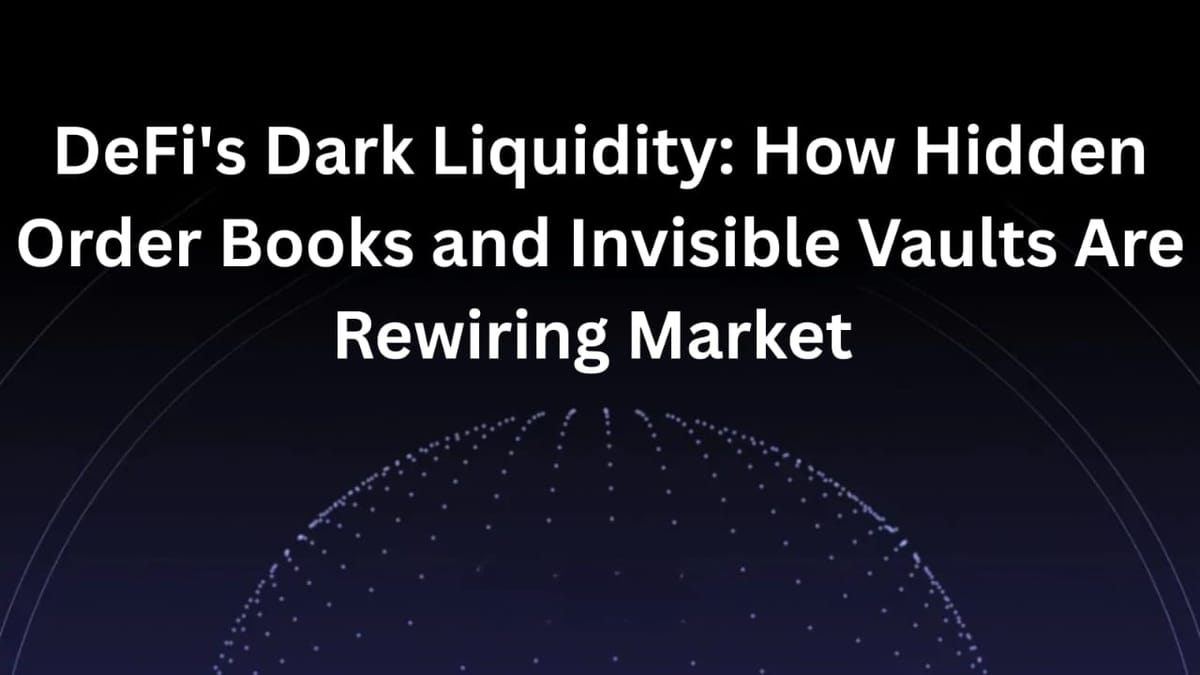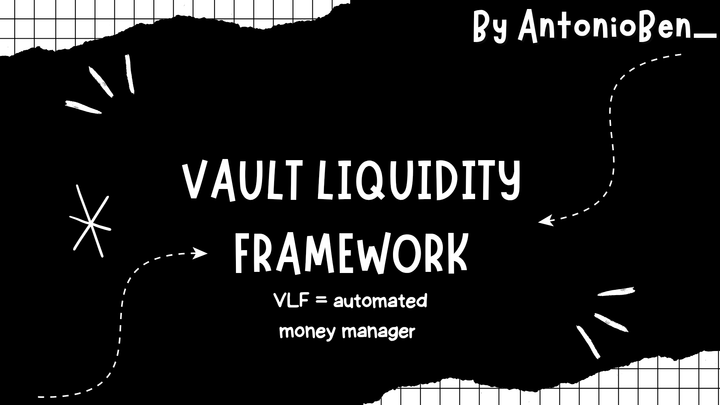DeFi’s Dark Liquidity: How Hidden Order Books and Invisible Vaults Are Rewiring Markets

Introduction
The decentralized finance (DeFi) ecosystem has rapidly evolved, introducing innovative financial products and services that challenge traditional finance. Among these innovations is the concept of dark liquidity, which refers to trading activities that occur away from public exchanges. This article explores the mechanisms of dark liquidity in DeFi, including hidden order books, invisible vaults, and the implications for market participants, particularly large traders or "whales." We will also discuss the emergence of MEV-resistant trading and private DeFi rails, which are reshaping how whales operate in this new financial landscape.
1. Understanding Dark Liquidity
1.1 What is Dark Liquidity?
Dark liquidity refers to trading activity that occurs outside of public view, often through private or less transparent venues. In traditional finance, dark pools are private exchanges where large institutional investors can trade without revealing their intentions to the broader market. In the DeFi context, dark liquidity manifests in various forms, including hidden order books and liquidity pools that are not immediately visible to market participants.
1.2 The Role of Hidden Order Books
Hidden order books are a critical component of dark liquidity. They allow traders to place orders without revealing their intentions to the broader market. This can help mitigate the impact of large trades on asset prices, reducing slippage and enabling more efficient execution. However, the lack of transparency can also lead to concerns about market manipulation and unfair advantages.
1.2.1 How Hidden Order Books Work
- Order Placement: Traders can place orders in hidden order books, allowing them to execute trades without revealing their strategies. This is particularly beneficial for large trades that could otherwise impact market prices.
- Matching Engine: A matching engine processes orders in the hidden order book, matching buy and sell orders without disclosing the details to the public. This ensures that large trades can be executed discreetly.
- Execution: Once a match is found, the trade is executed, often without the broader market being aware of the transaction until after it occurs.
1.3 Invisible Vaults in DeFi
Invisible vaults represent liquidity pools that are not easily accessible or visible to all market participants. These vaults can be used to aggregate liquidity from various sources, providing traders with better execution prices while keeping the underlying assets and strategies hidden. This can create a more efficient market but also raises questions about trust and security.
1.3.1 How Invisible Vaults Operate
- Liquidity Aggregation: Invisible vaults aggregate liquidity from multiple sources, including other DEXs and liquidity providers. This allows traders to access better prices and reduce slippage.
- Privacy Features: The assets and strategies within these vaults are often obscured from public view, providing a layer of privacy for traders who wish to execute large orders without revealing their intentions.
- Dynamic Pricing: By utilizing algorithms to determine pricing based on aggregated liquidity, invisible vaults can offer competitive rates while maintaining the confidentiality of their operations.
2. The Mechanics of Dark Liquidity
2.1 How Dark Liquidity Works
Dark liquidity operates through a series of mechanisms that facilitate trading without public visibility:
- Order Placement: Traders can place orders in hidden order books, allowing them to execute trades without revealing their strategies.
- Liquidity Aggregation: Invisible vaults aggregate liquidity from multiple sources, enabling traders to access better prices and reduce slippage.
- Execution and Settlement: Once an order is matched, the trade is executed, often without the broader market being aware of the transaction until after it occurs.
2.2 Benefits of Dark Liquidity
- Reduced Market Impact: By keeping large trades hidden, dark liquidity can minimize the impact on asset prices, allowing for more efficient trading.
- Improved Price Discovery: Aggregating liquidity from various sources can enhance price discovery, providing traders with better execution prices.
- Increased Privacy: Traders can execute strategies without revealing their intentions, protecting them from potential market manipulation.
2.3 The Role of Whales in Dark Liquidity
Whales, or large traders, play a significant role in the dark liquidity landscape. Their trading activities can have a substantial impact on market prices, making it essential for them to utilize dark liquidity mechanisms to execute trades without causing significant price fluctuations.
- Minimizing Slippage: By using hidden order books and invisible vaults, whales can minimize slippage, ensuring that they receive the best possible prices for their trades.
- Strategic Trading: Whales often employ complex trading strategies that require discretion. Dark liquidity allows them to execute these strategies without alerting the market.
- Market Manipulation Concerns: The presence of dark liquidity raises concerns about market manipulation, as whales may have the ability to influence prices without transparency.
3. Challenges and Risks of Dark Liquidity
1. Lack of Transparency
One of the primary concerns surrounding dark liquidity is the lack of transparency. This can lead to:
- Market Manipulation: The opacity of hidden order books can create opportunities for malicious actors to manipulate prices or engage in front-running.
- Trust Issues: Traders may be hesitant to engage with platforms that utilize dark liquidity due to concerns about the integrity of the underlying mechanisms.
2. Regulatory Scrutiny
As dark liquidity becomes more prevalent in DeFi, regulatory bodies are likely to take a closer look at these practices. Potential regulatory challenges include:
- Compliance with Securities Laws: Dark liquidity mechanisms may fall under existing securities regulations, requiring platforms to adapt their operations to comply with legal standards.
- Consumer Protection: Regulators may seek to implement measures to protect retail investors from potential abuses associated with dark liquidity.
3. Security Risks
The use of hidden order books and invisible vaults can also introduce security risks, such as:
- Smart Contract Vulnerabilities: Platforms that rely on smart contracts for executing trades may be susceptible to exploits if not properly audited.
- Liquidity Risks: Aggregating liquidity from less reputable sources can expose traders to risks associated with counterparty defaults or hacks.
4. MEV and Dark Liquidity
4.1 What is MEV?
Miner Extractable Value (MEV) refers to the profit that miners can make by reordering, including, or excluding transactions within a block. In the context of dark liquidity, MEV plays a significant role in how trades are executed and the potential for market manipulation.
4.2 MEV-Resistant Trading
To combat the negative effects of MEV, several projects are exploring MEV-resistant trading mechanisms. These solutions aim to create a fairer trading environment by minimizing the opportunities for miners to exploit transaction ordering.
- Fair Ordering Protocols: Some protocols are implementing fair ordering mechanisms that ensure transactions are processed in the order they are received, reducing the potential for MEV exploitation.
- Private Transaction Pools: By allowing users to submit transactions to private pools, traders can execute orders without revealing their intentions to miners, mitigating the risk of front-running.
- Decentralized Governance: Implementing decentralized governance structures can help ensure that the community has a say in how MEV is managed, promoting transparency and fairness.
5. The Future of Dark Liquidity in DeFi
5.1 Trends to Watch
- Increased Adoption: As traders seek more efficient execution and reduced market impact, the adoption of dark liquidity mechanisms is expected to grow.
- Technological Innovations: Advances in blockchain technology and smart contracts may lead to more sophisticated dark liquidity solutions that enhance security and transparency.
- Regulatory Developments: As the DeFi landscape matures, regulatory frameworks will likely evolve to address the challenges posed by dark liquidity, balancing innovation with consumer protection.
Conclusion
Dark liquidity is reshaping the DeFi landscape, offering new opportunities for traders while presenting unique challenges. As hidden order books and invisible vaults become more prevalent, market participants must navigate the complexities of this evolving ecosystem. The future of trading in DeFi will depend on the ability to balance the benefits of dark liquidity with the need for transparency and security.



Comments ()